“Travel advisers can help you research the best destinations, lodging, or activities for your particular group and travel goals, offering up specific advice that might be hard or time-consuming to find yourself. Those specializing in cruises might know which cabin to choose if you are prone to seasickness, while a safari planner could help you decide which park would be best for bird-watching or seeing specific animals, like rhinos.
Travel advisers typically have relationships with tour companies, hotels and cruise lines, sometimes through networks. Those connections can allow advisers to offer extra perks such as late checkout, free breakfast, airport transfers, a welcome basket or a credit to spend on a cruise ship.
“A good travel agent will be a better steward of your travel budget than you are,” said Guy Rubin, managing director of Imperial Tours, which arranges travel in China.”
An excerpt from an article written by Julia Weed at the New York Times. To read the full article, click here
The article was published on March 11, 2024, Section B, Page 4 of the New York edition with the headline: When to Let a Travel Adviser Plot Out the Itinerary for Your Trip.
The glittering J Hotel, housed atop China’s tallest building, The Shanghai Center, the third tallest in the world, curvaceously soars 128 floors over the world’s most stunningly glorious futuristic cityscape in an opulently Las Vegas-inspired flight of fancy. With a Shanghainese restaurant on the 120th floor, it’s currently the world’s highest hotel. Indeed, it’s a hotel of China luxury travel superlatives, whether you count the tiles of the Italian mosaic walls in its presidential Shanghai Suite, the sparkling prismatic refractions of French and Chinese crystal in its glass-faced bedrooms, the numerous international and Chinese works of art sprinkled throughout the public areas or, more blandly, the sheer financial cost of this absolutely gorgeously designed skyscraper. It’s also a story of firsts. Though they are the owners of many fine heritage hotels in the city, such as the Peace, Park, Metropole and Jinjiang Hotels, this is the first time the Jinjiang group is attempting to manage a first-tier luxury hotel. This is also the first time, the world has heard of the new “J Hotel” (J for Jinjiang). And whilst, there are various mainland Chinese-owned and managed five-star hotels, this is the first time a mainland Chinese brand, private or public, is asking to be judged as best in class at the luxury level anywhere in the world (as defined by consistently justifying highest city ADR).
To lead the charge, they have employed a veteran China hand, Richard Yap from Singapore. He has an extensive resume incorporating western luxury brands from Aman to Raffles along with mainland Chinese ones such as the Beijing Commune. He knows the standards expected of top tier luxury China hotels and has the local experience necessary to work within a local work style and management structure. Aware that he needs to achieve exemplary service levels, he has convinced his task masters to invest in a team of well-trained butlers. These are to coordinate service delivery between the various hotel functions to demanding guests, both domestic and international. Of course, because of Covid, so far most hotel users have been mainland Chinese. Like many China luxury hoteliers, Richard is keen to have the opportunity to take his staff and property to new heights by excelling with a smorgasbord of nationalities. He commented – “western and Chinese guests focus on different parts of the hotel experience, and we want to be able to cater to both”.
Jinjiang International Holdings is the largest travel conglomerate you have never heard of. With significant shareholdings in a number of major hotel groups such as Accor, Radisson and Louvre Hotels, as well as Shanghai Disneyland, this aggregation of four listed state-owned companies manages over 7,700 hotels in 67 countries, a fleet of 10,000 vehicles and is a major outbound tour operator. It is the fifth largest hotel group in the world, and J Hotel is its calling card.
Occupying the 84th to 120th floor of the Shanghai Center, J Hotel features 165 bedrooms including 34 suites. It peers down at the neighboring 101 floor Park Hyatt and the stunning 88 floor Grand Hyatt beneath, themselves the third and sixth highest hotels in the world, creating between them an iconic architectural triptych that has come to define the Liujiazui skyline as distinctly as the Peace Hotel and HSBC building define the early twentieth century Bund across the river.
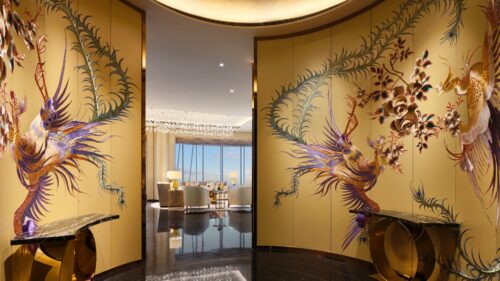
Imagine the “Contemporary” guestroom as a crystal box suspended in a glass skyscraper. 610 square feet (61 sq m) large, the space is sectioned with movable semi-transparent screens into dressing, sleeping and washing areas. Laminated glass with a magnolia pattern contains the white marble-floored bathing area. The chief decoration in the sitting area is an Italian crystal display case featuring Lalique and Chinese glassware with some Tang-dynasty inspired ceramics. A more recent selection of guest rooms are styled as “New Chinese” – the key differences being a more typical and firmer division between bathroom and bedroom areas and more traditional Chinese decoration such as a wooden tea table and gold-accented sofa. The suites, starting from 1,000 square feet (100 sq m), echo the Contemporary style. Their apotheosis comes in the extravagance of the Shanghai Suite – highlights include two large embroidered phoenixes from Suzhou in the round entry vestibule, a crystal structured four poster bed and a yinyang double sink in the bathroom, whose walls are covered in incredible mosaics, reminiscent of the 120th floor Shanghainese restaurant. The flamboyance of this suite is uncharacteristic of the conservativeness associated with East Asian business culture, but typical of the adventurousness that drives it.
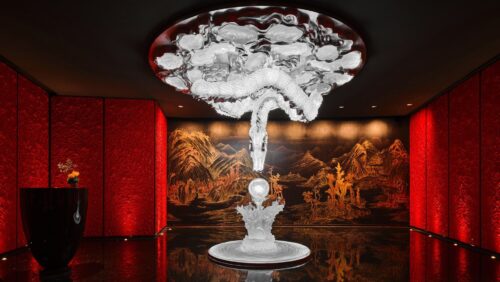
Although it’s hard to decide, to my mind the most stunning area of this incredibly ambitious hotel is in the Cantonese restaurant – “Jin Yan”. One passes through a red glass “Shikumen style” gate into a dark, black-marbled corridor at the end of which coiling down from the ceiling towards a pearl beneath is an illuminated pale blue Chinese dragon. As this is reflected in the black marble floor, we in fact see two dragons fighting over a pearl between them, a traditional Imperial motif that you will also see frequently in the Forbidden City. If this is not magnificent enough, the private dining rooms, styled around the colors of the traditional, five Chinese elements offer their own artistic apotheoses. One dining room’s ceiling is entirely decorated in spirals of dark blue crystal peacock feathers; another features illuminated white crystal clouds. Really, each room belongs in a museum. And all of it overlooks a vast city panorama in which fifty story buildings appear as inconsequential grey stumps of uncouth concrete in the lowly distance.
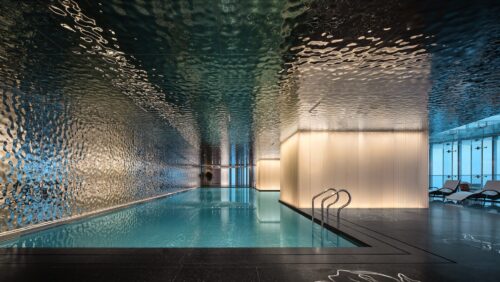
Although the gym on the 85th floor is spacious and admirably well-equipped and the view up to the roof from the swimming pool on the 84th floor in the outer shell of the skyscraper gives an amazing perspective, I do have two criticisms of the hotel in this area. The first is that the exercise and swimming area do not include a steam or dry sauna amongst their facilities. (That said, some of the suites do come with their own individual dry saunas.) The second is the stubborn insistence of Shanghai city government that hotel residents wear swimming caps in the city’s swimming pools. This outmoded regulation is rarely enforced at luxury hotels in other cities in China, and I suggest firstly that Shanghai be advised to phase it out and secondly and more controversially that J Hotel be encouraged not to enforce it.
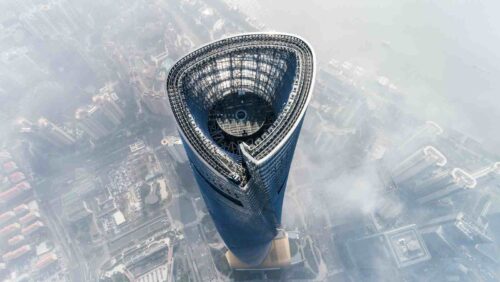
Although a hotel guest is bound to find a satisfying morsel to eat at one of the Italian (101st floor), Shanghainese (120th floor), Cantonese (103rd floor) or Japanese (104th floor) restaurants, it would be criminal not to mention the wonderful tea/light dinner service that is available to all hotel residents every day at the Yi Lounge on the 84th floor on a complimentary basis. My son and wife had a marvelous time enjoying its tasty delicacies, perhaps only matched by the pastries that are available in the patisserie on the ground floor to people rushing to or from this property. That said, rushing this hotel does seem misguided. It is indeed entirely worthwhile to follow one of the tours of its many art holdings. An abiding highlight of my stay at the J Hotel is the access the property was able to give to the “Eye” on the 126th floor. This is a sculpture in the shape of an eye that sits atop a massive 1,000 ton damper that is attached by steel cables to the top of the building. As in other skyscrapers, this “tuned mass” damper system provides a counter-veiling force in the event of a typhoon, preventing the building from swaying. The building’s curved design, running through a 120 degree turn also helps it pass more easily through such weather systems. Although the light show that accompanied my visit would appeal to few adults, seeing the technology, with echoes of Sauron’s Tower from Lord of the Rings, was an eye-opening experience.
The J Hotel is a bold statement, characteristic of a city and country that sees itself as going places. Love it or hate it, it’s difficult not to be thrilled and impressed by it. Certainly, it raises the stakes for other leading hotels of this iconic metropolis. On one bank of the Yangzi River, a visitor sees a handsome array of early twentieth century Art Deco buildings. In their day, these grandiose buildings bespoke the power and reach of the British Empire. On the other, dwarfing them, you now have the most resplendent architectural statement of the twenty-first century, and towering over it all is the J Hotel.
4 years ago I co-founded Imperial Tours, an inbound luxury tour operator in Beijing, where I lived for 20 years. As a result of the Covid pandemic, I was trapped outside China from November 2019 until three weeks ago when I returned for the first time in over three years. This article describes the changes I found on reopening China’s travel industry.
The Rise of “Genuine” Boutique Hotels
When China first opened to the travel industry in the 1980’s, one of its only sources of foreign currency was the inbound market. Since that beginning the impact of overseas tourists was factored into every decision in the development of the hospitality sector. During Covid however, China was shut off from the outside world and as a result the hospitality sector advanced within its own bubble.
There has impacted a number of things, but one of the most notable has been the rise of the genuine boutique hotel. I write “genuine” because at the first boutique hotel conference in China (at which I spoke), boutique hotels were defined as having up to 100 rooms, which is not how most western travel agents would understand it. However, after being closed off by Covid for more than three years, the spending of affluent upper Chinese classes traveling domestically has caused a mushrooming of interesting boutique hotel alternatives both outside big cities (prompted by the local staycation market) and in China’s longstanding leisure destinations.
There’s of course one problem generated by this organic growth – in many instances, these boutique hotels are ill-equipped to handle foreign visitors. Yangshuo Misty Wonderland Hotel is a perfect example. This luxurious 28 key hotel comprised of villas and very spacious rooms with generous balconies sporting their own capacious baths offers one of the most stunning, if not the most spectacular, view and location in the entire country. (Above photo is of me sitting on a bench located within an ornamental swimming pool in front of the mountainscape.) Not bad, right?
Buildings are styled on the traditional architecture of the Han and Tang dynasties. Yet not only is there not a single staff member able to rub two words of English together, but there are no western dishes on any of the hotel menus. There is no concession anywhere to the potential demands of a non-Chinese speaking tourist – something that would have been unthinkable prior to Covid.
The same is true at the delightfully landscaped Tong Resort in the same area. But do not lose hope – Jora, a 35 room “Small Luxury Hotel of the World”, in the same area had the most resourceful staff at any hotel I have ever encountered and accommodates English speaking guests.
As we move beyond the first phase of China’s reopening, the re-introduction of overseas tourists to China’s inbound market coupled with the reduction in demand from the domestic traveler, will inevitably encourage this new wave of Chinese boutique hotels to invest in services for overseas travelers which can but enrich the market and textured experience of travel in China.
Fewer QR Codes And More Real Menus
If you’re anything like me you stifle an internal groan when you walk into a restaurant and are compelled by the waiter to scan a QR code to browse online to the restaurant menu, which you subsequently peruse with difficulty on your annoyingly limited mobile phone screen. This was a digital innovation introduced during Covid to reduce the spread of infection.
I object to the impersonality of this characterless functionality, and so am cheered by a trend in techno-addicted China tilting in the opposite direction. When I went to dine at Michelin one star, Poetry Wine, I was thrilled to be handed a thick, large format volume with a photo of each dish with its name, price and ingredients printed on individual pages of high-quality paper.
I was dining amongst a group of friends and we all started to discuss the menu and our choice of dishes. The menu prompted an entertaining conversation that became the foundation of a hearty and enjoyable dinner. Ignace Lecleirc, a successful restaurateur and owner of a wide stable of Beijing eateries including the fabulous Michelin one star fine-dining establishment, Temple Restaurant Beijing – Hutong, assures me that this trend is now becoming well-established.
A New Digital Divide In China
When people speak of a digital divide they typically refer generationally to the elderly failing to keep up with the technology of the day, not the bifurcation of American and Chinese internet systems with their separate app universes. Whilst I can travel freely between western Europe and America and use the same apps such as Uber, Booking.com, Google Maps and Whatsapp, that borderless digital experience totally collapses at Chin’s border.
Not only do all apps owned by Google or Facebook not operate in China, but moreover, China’s digital universe is comprised of an entirely different set of apps. For navigation, you would use Baidu or Gaode, the first of which does not even seem to be available to non-China registered accounts. Restaurant recommendations are on Dianping. Ride hailing is on Didi, payment services rely on Alipay or Wechat and ctrip would be used for travel bookings. It’s an entirely different app universe and with the exception of ctrip, which offers trip.com outside China most of these apps are not going to be easy for the traveler to use in China because of linguistic and logistical barriers.
What this means in practice for overseas travelers, for example, is that whilst travelers can always get the hotel concierge to order them a cab to a restaurant, which the concierge would still be required to suggest (as travelers cannot access Dianping’s restaurant suggestions for linguistic reasons), for the return journey, travelers would require the restaurant to order them a cab back to the hotel. It seems that most cab drivers are accepting cash, so payment in that situation is not an issue. However, travelers can no longer presume to be able to hail cabs as these are mostly responding to ride-hailing apps now. These are the kinds of considerations that travelers will need to incorporate within their journeys through China. Increasingly, access to China’s digital services is leaving overseas visitors behind.
Like an anxious child fearing the loss of his mother, so on my most recent trip did I worry about how I might possibly negotiate life in China without my mobile phone. As I participate within China’s digital universe, I understand its reach and ubiquity such that on the one hand I fear for travelers who cannot access it and on the other, I am subsequently insensitive to situations where overseas travelers, particularly independent travelers making their way without the help of a local operator, might struggle with the most basic aspects of digital life there.
Of course, no article on the Chinese internet is complete without emphasizing the need for overseas travelers to equip themselves with a solid VPN service prior to travel there in order to access their favorite western web sites and services. Indeed, I would now recommend travelers subscribe to two different VPN services so that in the event one is blocked or ineffective, they always have the other to turn to and use to gain access to Instagram, Facebook and Google, etc.
The New Greater Bay Area
This is something that has not garnered attention in western media but deserves mention. The Chinese government first documented its intention to create a Greater Bay area in 2017. The idea is to integrate Hong Kong, Macao, Guangzhou, Shenzhen and five lesser known successful, southern cities within an environmentally sustainable and technologically progressive development plan. And when the Chinese government decide on these strategic plans, there’s usually good reason and they usually happen.
So here we are six years later following the construction of interconnecting high speed rail links, bridges and airport clusters along with new rules facilitating the movement of people and goods between these areas. For the travel industry, our attention needs to be focused on Macau in particular as this has been designated the travel hub within the plan.
Already known as a destination for gambling, following a recent crackdown on junkets (associated with money laundering), Macau is seeking to develop alternate revenue streams. Las Vegas provides obvious direction, but in addition, I have been told, significant funds are soon going to be devoted to promoting recreation and the arts across this area.
This message was echoed by Meg Maggio, an art aficionado of many years standing in Hong Kong, who advised that big plans are afoot in the world of art across the entire Greater Bay area, not just Macau. How this will impact travel we will wait to see, but it’s worth just mentioning now.
The No-Show of Outbound Chinese Travelers
As this is relevant but unwelcome, I will cover it briefly. Major travel suppliers in the west might have been expecting a sudden rush of Chinese clients in the wake of China’s re-opening. I am sorry to report that this won’t be happening in the immediate future. As a result of political tensions, countries have been grouped into friendly and unfriendly sets, with Chinese outbound groups able currently to travel only to those deemed friendly. France qualifies as friendly, but UK and US do not for example. Whilst FIT travelers can travel freely, groups are subject to this restriction. I would anticipate that the warming of international relations will quickly address this lagging stricture.
We are still of course very much in the early days of China’s reopening and many of the apparent obstacles, such as the continuing lack of trans-Pacific flights, will surely be bridged in due course. As that happens, no matter if you have already been to China many times, like me you will always find that it has shifted in your absence and that there’s always something new to discover and enjoy.
First published in Insider China Report on June 13, 2023.
FOR IMMEDIATE RELEASE: August 14, 2017
Contact: Jacqueline Soto, 480-430-7511, Jacqueline@slentertainment.com
Guy Rubin, +86 10 8440 7162 guy@imperialtours.net
IMPERIAL TOURS GREAT WALL PRIVATE BANQUET RECOGNIZED AMONG TOP TRAVEL EXPERIENCES
Scottsdale, AZ – An experience offered by Imperial Tours was recognized as one of the top experiential travel offerings at the inaugural CHAD CLARK CERTIFIED 25, a first-of-its-kind travel initiative that annually lists the top 25 travel experiences or products throughout the world. The winners were announced in a special interactive event at the Bellagio in Las Vegas on August 13 in front of leading travel professionals.
Chad Clark, principal and owner of Chad Clark Travel Ventures, is a travel industry expert and self-described, “experience junkie,” who has spent years seeking out top-of-the-line travel experiences and services. Now, he is providing a platform for the best in travel to share theirs.
Clark aims to set the industry standard for luxury travel with the inauguration of the CHAD CLARK CERTIFIED 25, an elite list of the world’s most prestigious, authentic and unique travel experiences or products. Great Wall Private Banquet was among the first recipients of this prestigious honor.
“We are humbled and overwhelmed by the immense number of submissions we received from travel providers across the globe,” said Clark. “It is an honor and a thrill to unveil the very best in luxury travel through the CHAD CLARK CERTIFIED 25. This initiative provides travel suppliers with an opportunity to have their premium experiences recognized and promoted in an innovative way, while simultaneously connecting travel advisors, and ultimately travelers themselves, with exclusive, thoroughly vetted travel experiences that have an industry seal of approval.”
About the Great Wall Banquet
When we hear these days of the daunting logistical and financial challenges of building a wall across the southern border of the US, it brings home the magnificent achievement of the Chinese in resolving exactly these issues many centuries before as they built successive fortifications across their northern frontier to protect their agricultural heartlands from aggressive nomadic invaders from the north. These fortifications are known to us today as the Great Wall of China. The incredible experience we are presenting is the opportunity to walk the Great Wall with the British conservationist who was instrumental in developing the law to protect it, and then to enjoy a white linen banquet in a guard tower.
What astounds visitors about the Ming dynasty Great Wall (1368-1644) is its surprising beauty. Whereas the sections closest to Beijing are the largest with the most tourists, more remote sections benefit from fewer visitors and less renovation. The centuries-old 5 meter high “wild wall” – as conservationist William Lindesay calls it – these days does not dominate its surrounding landscape so much as delineate, define and embellish it. William will introduce his thirty year association with the Great Wall, starting with being the first foreigner ever to walk its entire length, to now when he is known through China as the Guardian of the Wall. After a thorough introduction to his efforts to improve its conservation, you will be taken to a remote spot to enjoy a remarkable banquet on the Great Wall of China.
About Chad Clark Travel Ventures
A self-proclaimed “experience junkie,” Clark gave up corporate life to follow his love for food, wine, culture, destinations, a.k.a. extraordinary travel experiences, and turn it into a business that helps people make the absolute most of their most precious commodity – their time.
Whether traveling with friends, family or alone on a research trip, Clark is all about the experience – and when he finds one he is passionate about, he just has to share it with his clients and friends. He and his company have the contacts, relationships and dedication necessary to ensure his clients have the best possible experiences. Clark has dedicated his life to travel and is amassing an ever-growing “Experience Journal” that he shares online through social media. Viewers can follow Clark through Rome, Sydney, Paris and even in his own backyard golfing in Scottsdale, Arizona. Clark and his team are committed to sampling, connecting, building relationships and, in essence, helping his clients live their next big adventure.
Chad Clark Travel Ventures works with people who recognize that the types of trips they want require more than time and planning – they require knowledge, experience and connections, all of which Clark and his team can provide.
Chad Clark Travel Ventures, an independent affiliate of Camelback Odyssey Travel – a Virtuoso® Member.
For more information on CHAD CLARK CERTIFIED 25, please visit www.chadclarkcertified.com.
As a country with a global reputation for cheaply manufactured goods, China is now making moves to shake off its ‘Made in China’ label and show the world its capacity for innovation, creativity and ingenuity.
That said, China’s fashion industry is caught in a contradiction. China is one of the largest producers of fake luxury goods, while at the same time boasts the single largest market for luxury retail in the world. This contrast has become the perfect breeding ground for a multi-faceted and diverse shopping culture to arise.
Repression of Expression | Understanding the Roots of Modern Chinese Fashion
To understand where China’ s fashion industry is headed, it is crucial to first understand more about China’s past ‘fashion’ standards. Up until the early ‘90s, China had virtually no brands or self-expression to speak of. Due to high inflation and a weak economy, Chinese people were relatively poor, only spending money on essential items. In addition, prevailing communist ideology meant standing apart from the crowd was seen as bourgeois and regarded unfavourably. Conformity was the ‘in-vogue’ fashion statement. The streets of China during this period were a sea of military green jackets, blue Mao-suits and grey workers’ robes. For women in the ‘50s and ‘60s the most desirable fashion accessory was a leather belt used to accentuate their waists in an effort to distinguish them from men.
After the ‘90s, as a result of China’s economic reform and soft embrace of western culture, much-needed swatches of color were introduced into the dull shades that had dominated China’s ‘fashion’ scene for over four decades. In contrast to the repression of previous times, the floodgates of ‘anything goes’ fashion unfurled across the country, hitting major cities like Beijing and Shanghai. Today, the shockwaves from this period still reverberate amongst Chinese women in their 40s, 50s and 60s. For example, today it would not be uncommon to see such women clad in brightly colored clothing adorned with sparkles, funny pictures and often ironic English text.
A New Take on ‘Made in China’
Today China’s latest and hottest fashion designers are a product of changes that took place in ‘80s. This is because children born in this period became the first generation of Chinese to have the luxury of going abroad and experiencing the world beyond China’s borders. With the implementation of the One Child Policy in 1979, the traditionally large Chinese family was reduced to three members. Combined with a growing Chinese economy, these smaller families had more money to spend on education and experiences for their one child. With new wealth and more open borders many Chinese families in this generation opted to send their only child to attend school outside of China. Those interested in pursuing fashion and design followed their passions to gain admittance to prestigious design schools in London, New York, Paris and Milan. Many of these pupils gained experience with some of the world’s most renowned designers before returning to China to develop their own labels and boutiques. This influx of returnee Chinese fashion designers, fusing Western and Eastern statements, and with a better understanding of Asian body proportions, has resulted in some of the hottest fashion brands and designers around today.
On the Catwalk
HAN FENG
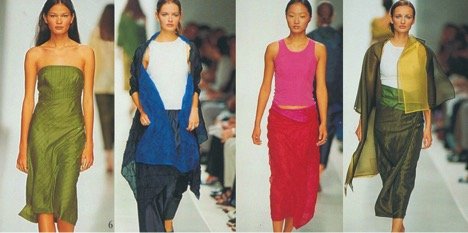
The first Chinese designer to have her garments grace the catwalk at New York Fashion Week in the early ‘90s, Han Feng is a pioneer in the Chinese fashion industry. Her signature style showcases intricate pleating with timeless silk fabrics in colors and designs that change seasonally. In an effort to seamlessly blend the divide between Eastern and Western fashion culture, Feng’s dedication goes beyond simply fusing East and West. Completely devoted to the purity of her craft, Feng prefers to meet with her customers personally to exchange a dialogue where she is able to share recommendations and customize the shopping experience.
MASHA MA
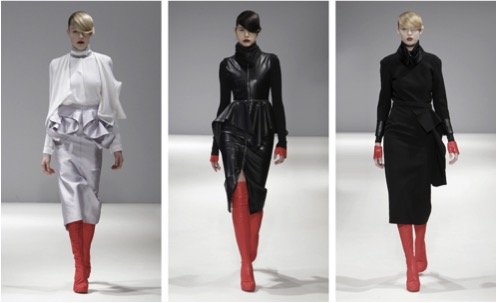
Since the launch of her label in 2008, Masha Ma has gained instant international attention for her chic and futuristic designs. Having worked with designer labels such as Alexander McQueen and Dolce & Gabbana, as well as counting Lady Gaga and Naomi Campbell among her customers, Masha Ma is one of the most celebrated fashion designers in China. With a boutique shop in both Shanghai and Paris, the Beijing native regularly presents her collections during Paris Fashion Week. Her signature style is a combination of effortless modern femininity coupled with brash industrialism.
HUISHAN ZHANG



Leaving China at the age of 17, Huishan Zhang started his extraordinary career being hand-picked by Delphine Arnault to spend his third year of fashion design study in the House of Dior in Paris. After graduation, Zhang created a luxury brand combining Eastern and Western influences. This marries feminine details with strong lines. His couture ‘Dragon Dress’ has become a permanent piece in London’s Victoria & Albert Museum. In addition to having dressed Gwyneth Paltrow, Keira Knightley, Helen Mirren and Samantha Cameron, Zhang’s collections can be found at upscale department stores such as Barneys and Joyce.
YIGING YIN

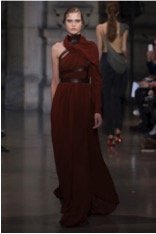
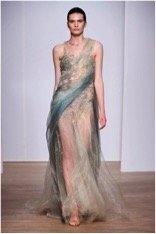
Born in Beijing in 1985, Yiging Yin studied fashion in Paris before launching her own brand in 2010, designing clothes in her apartment. From humble beginnings Yin has since received multiple awards and has showcased her collection during the prestigious Paris Couture Week. Yin’s designs emphasize pleats, fluid lines and femininity. As the first Chinese-born, not to mention the youngest, designer to be admitted to Paris’s exclusive elite coterie of haute couture designers, Yin is a designer to watch.
UMA WANG

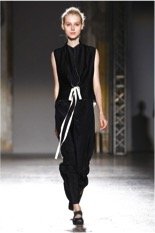
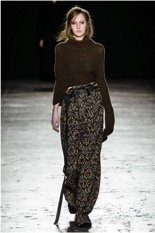
One of China’s most famous fashion designers, Uma Wang has showcased her collection at all the major fashion weeks. After ten years designing textiles and patterns for Chinese labels, Wang launched her own namesake label in 2009. Her signature knitting technique and dedication to balancing fashion with functionality has consistently won her accolades both in China and abroad. She is particularly skilled in mixing and matching different fabrics and textures to create simple but strong garments with subtle detailing.
GRACE CHEN
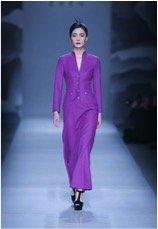
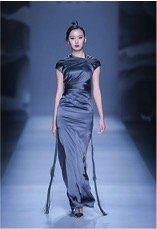
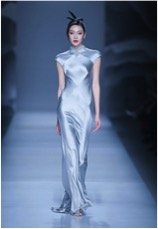
After studying and working in New York for 15 years, Grace returned to Shanghai to open her own couture brand in 2009, The House of Grace Chen. Officially opening its doors in 2016, and located in Shanghai’s trendy French Concession, Chen’s boutique resides in a beautifully restored heritage Art Deco villa originally built in 924. This artistic mansion integrates a collection showroom, VIP fitting salon, an art gallery, library, dining room and fashion lounge all in a seamlessly designed open concept space. No stranger to the lime light, Chen’s garments have been worn by Chinese mega-celebrity Fan Bingbing and international celebrities such as Oprah Winfrey and Helen Mirren.
MA KE

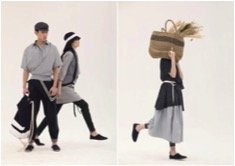
Celebrated for her dedication to preserve Chinese traditions and her commitment to environmental consciousness, Ke has developed two designer labels: Exception de Mixmind a ready-to-wear line and Wuyong a haute couture line. A true innovator, Ke’s Exception de Mixmind label is often referred to as China’s first designer brand. She is one of very few Chinese designers who have been allowed to present at Paris’ Couture Week. In addition to international recognition, China’s First Lady Peng Liyuan has also worn Ke’s designs on several occasions. His signature style incorporates an emphasis on environmentally friendly fabrics and uses locally sourced cotton, silk, linen and wool material. Techniques used include traditional dyeing, weaving and embroidery inspired by local minorities from the South of China. Ke has even gone so far as to incorporate traditional sewing equipment into her collection such as a Chinese loom dating back to the 19th century.
GUO PEI
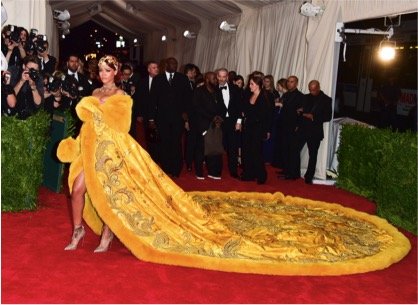
Best known for designing garments for Chinese celebrities and Rihanna’s trailing yellow gown for the 2015 Met Ball in New York, Guo is one of China’s most influential designers and was listed as one of Time Magazine’s 100 Most Influential People in 2016. Often compared to the likes of Alexander McQueen and Coco Chanel, Guo’s style incorporates materials such as silk, fur and embroidery work, borrowing heavily from traditional Chinese imperial court design. One of Pei’s silk couture evening gowns embroidered in gold can be viewed on display at the Metropolitan Museum of Art in New York City. As a result of her elaborate and distinct style as well as international media exposure from her unique designs, Pei is one of the most recognizable Chinese designers among Western audiences.
The Future of Runways
‘Made in China’ is being transformed by emerging internationally acclaimed designers capitalizing on more liberal fashion trends. China has become a blank canvas for designers to make their mark in the largest luxury market in the world. While it is undeniable that China has made incredible advances in the fashion industry in the last two decades, there is a still a long road ahead before Beijing and Shanghai Fashion Week will have the same international outreach as Paris, London, New York or Milan. However, considering how dynamic China’s fashion industry is and given its large consumer base, it is only a matter of time before Fashionistas on 5th Avenue excitedly open the newest Vogue to check out the collections coming out of the Middle Kingdom.
Shopping with Imperial Tours
Whoever said that money can’t buy happiness, simply didn’t know where to go shopping – Bo Derek
‘Custom made’, ‘couture’ and ‘exclusive access’ are just some of the terms you come across on a Shopping Itinerary with Imperial Tours. Our team can design bespoke shopping tours incorporating designer boutiques in Shanghai, Beijing and Hong Kong. We can also arrange a personal dress fitting with some of China’s design icons. Contact us to find out more about these labels, where to find them and how Imperial Tours can arrange a unique and exclusive shopping experience in China.

Marketing China has never been more exciting, easy and profitable. As you may know Imperial Tours has partnered with Peninsula Hotels to bring you Peninsula Private Jet Tours Through China. Through this collaboration we have developed three bespoke travel experiences through China: Culture & Heritage, Family and Culinary. But what you may not know is that we have also developed a marketing plan designed to help you get the word out about these itineraries. Our Marketing Plan gives you the tools you need to promote and share Peninsula Private Jet Itineraries through multiple mediums. The idea behind sharing our marketing plan with you is to take the guesswork out of promoting these experiences. Essentially, let us do all the work for you and all you need to do is share!
These itineraries are packed full of once-in-a-lifetime experiences. If they are booked privately, itineraries can be further customized for alternative dates or embellished with different destinations, and if wished they can also be booked on commercial flights.
Our Marketing Calendar (click to download) is complete with step-by-step instructions on how to market and capitalize on each itinerary. All you have to do is follow five easy steps and let Imperial Tours do the rest.
Follow us on Twitter, Facebook and Instagram to get content on Peninsula Private Jet Tours that you can share with your followers.
Click to download our Marketing Calendar made especially for you. This calendar provides you with a detailed, easy to follow, marketing campaign that you can print out and follow to promote these tours. Additionally, our Marketing Calendar provides you with easy to follow instructions on how to repost and share from Facebook, Twitter, Instagram and E-blast.
Over the next 3 months, starting in November 2016, we will be sending out 3 e-blasts relating to a specific Peninsula Private Jet Itinerary; Culinary, Family and Culture & Heritage. Each e-blast will be created so that you can forward the information to anyone you think might be interested in one of these amazing experiences.
Each one of our 3 e-blasts will have a social share button that allows you to share each itinerary on Twitter, Facebook & Instagram. Simply click the social share button for each social icon and share!
After generating interest in each tour contact us to help you book one of these amazing journeys. Note: private tours based on these scheduled departures can fly commercial and be further customized.
Our Culinary Voyage e-blast will be sent shortly after American Thanksgiving. This one of a kind itinerary provides opportunities for your clients to try their hand at creating traditional Chinese dishes such as Peking duck, Dim Sum and even noodle throwing. China is a “must-eat” destination for all foodies; our Culinary Voyage is a 10-day tour highlighting the best eats China has to offer. Our culinary tour is ideal for groups of 8 or less. Tours are approximately USD$26,050* per person based on double occupancy. To view a detailed itinerary click here.
Our Family Tour e-blast will be sent in early December, in time for Christmas as the perfect once-in-a-life-time holiday gift for the whole family. This 11-day tour showcases the best of China in a safe and family-friendly interactive setting. This tour is ideal for small to medium sized families who are looking for a unique holiday experience and enjoyment for the whole family. Tours begin at approximately USD$102,120* per family of 4. To view a detailed itinerary click here.
Our Culture & Heritage itinerary will be sent out after the New Year and is equipped with unparalleled access to some of China’s most significant cultural artifacts as well as leading creative minds shaping China’s artistic landscape. This 10-day tour will introduce you to private collections and VIP access to China’s cultural treasures. This tour is ideal for clients who are looking for exclusive access to all that China has to offer. This tour is suitable for small groups as well as families. Pricing begins at approximately USD$25,530* per person based on double occupancy. To view a detailed itinerary click here.
*Price is subject to change based on fluctuating exchange rates.
Imagine exploring three of the worlds most dynamic and fast paced cities from the comfort and convenience of a private jet. Imperial Tours has partnered with Peninsula Hotels, renowned for flawless service and quality, to provide you with the ultimate China experience, Peninsula Hotels’ Private Jet Tours. We have crafted three themed itineraries – Culinary, Family and Culture & Heritage – each designed with immersive experiences to captivate you while introducing the rich culture, cuisine and history of China.

Experience a journey like no other on a Peninsula Private Jet Holiday
For many people, the thought of visiting China sparks a sense of wonder and excitement for the mysterious culture of the East. As one of the most populated and diverse countries in the world, China provides a cornucopia of experiences engaging all the senses. While this temptation to discover the East is an enticing lure it can also be overshadowed by fear of the unfamiliar. With Peninsula Hotels’ Private Jet Tour itineraries you will experience the reassuring comforts, anticipatory service, and soothing attention to detail of legendary hotelier, Peninsula Hotels. In this way, the exoticism and mystery of the East can be enjoyed from the reassuring platform of some of the world’s leading hotels.
Each tour provides access to one-of-a-kind bespoke experiences only available as a result of the partnership between Imperial Tours and Peninsula Hotels. For example, you will explore a seafood bazaar in Hong Kong with the Executive Chef of the Peninsula Hong Kong and learn to paint with the Peninsula Beijing’s resident artist. Alternatively, try climbing aboard Peninsula Shanghai’s private yacht for an architecture tour of its future cityscape from the Yangzi River. Each itinerary features unique hotel experiences in China born of the collaboration between Peninsula Hotels and Imperial Tours.

Private access to world renowned cultural sites is merely a starting point for our Culture & Heritage tour. Apart from meeting with some of the most influential leaders in China’s arts and culture sector, you will also view rare art collections normally closed to the public. For instance, you will tour meet and enjoy lunch with the founders of China’s leading home-grown auction house and also tour private galleries in Beijing and Shanghai with gallery owners. In Beijing, you will not only enjoy a private lunch al fresco on the Great Wall of China but also meet with the conservationist responsible for the law protecting it.
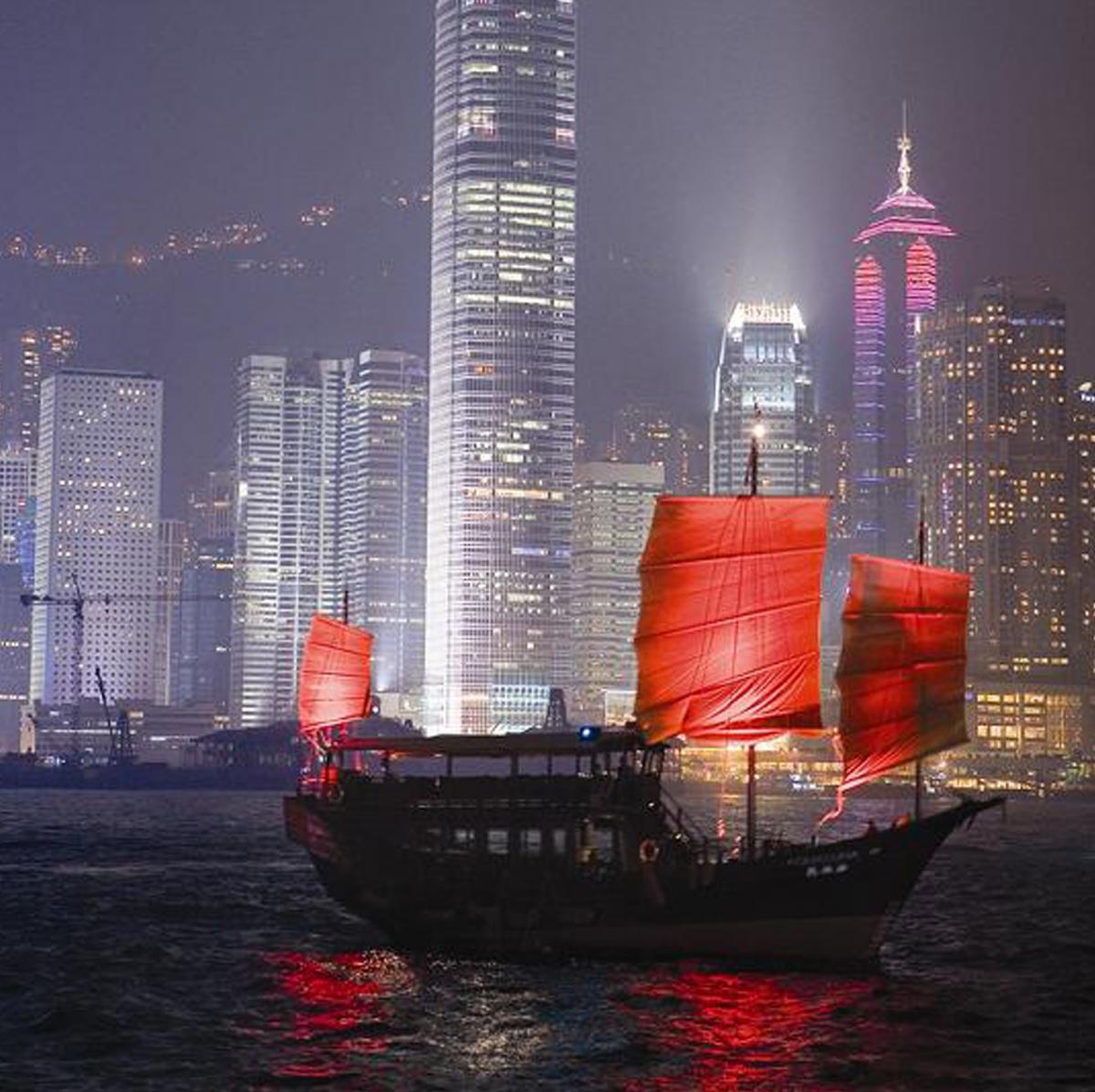
Culture & Heritage Tour, uncover the mysteries of the east from the comfort you can only experience with Peninsula Private Jet Tours
A family vacation by private jet not only eases the stresses of traveling with a family; it also provides a relaxing environment to connect and spend quality time together between destinations. Enjoy the ultimate family vacation in China with experiences ranging from a Chinese cooking lesson with a Peninsula Chef to painting lessons with the resident artist in Beijing’s Peninsula property to playing table tennis with a former Chinese Olympian. Other highlights on our Family Tour include, hand-feeding pandas and enjoying VIP access to the newly opened Shanghai Disney. We have curated only the best experiences to ensure that each member of the family is captivated and entertained, providing you with a relaxing, memorable and safe vacation abroad. Make your next family vacation one filled with unforgettable experiences sure to entertain, bring you closer together as a family and introduce your children to the magnificence of China.
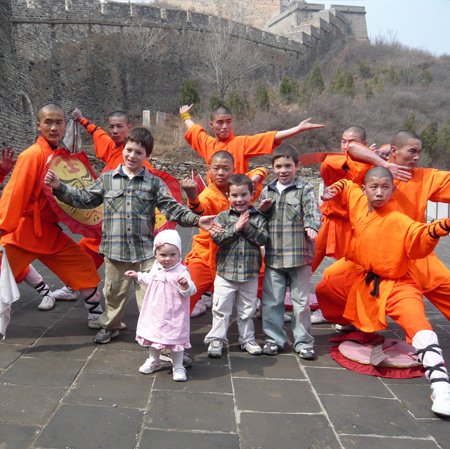
Family Tour, give your family an experience they will never forget from the safety and comfort of a Peninsula Private Jet Tour
China is a “must-eat” destination for foodies everywhere and our Culinary Voyage private jet tour offers the best China has to offer. Given our destinations of Beijing, Shanghai and Hong Kong, we focus on three main schools of cuisine; Imperial, Huaiyang and Cantonese from the perspective both of fine dining and home-style cooking. Together with Peninsula Hotels we have created a tour that provides exclusive access to Peninsula’s private kitchens as well as opportunities to learn, shop and cook with the best. For example, the Executive Chef of the Hong Kong Peninsula accompanies you on a traditional junk to his favorite island seafood bazaar. Alternatively, a TCM qualified nutritionist introduces you to China’s leading farm to table organic restaurant specializing in traditional cooking techniques. You will be introduced by experts to the art of preparing and cooking some of China’s most famous dishes from Peking duck in one of Beijing’s top duck restaurants to hand thrown noodles and dim sum. No matter your palette, our culinary tour will leave you with a newfound appreciation for the range and art of Chinese cooking.
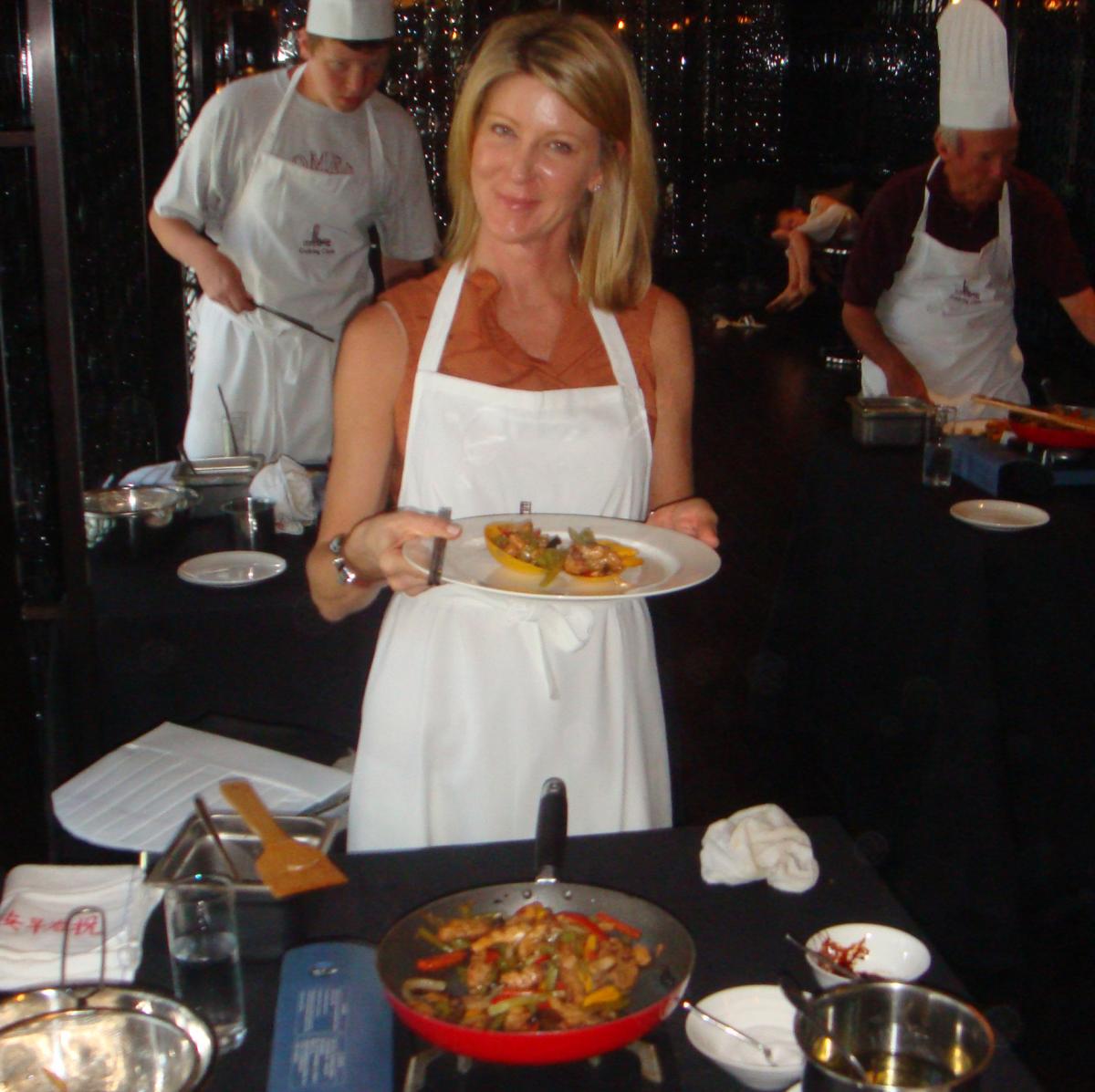
Culinary Voyage, learn the art of creating some of the most iconic dishes in Asia with Peninsula Hotels & Imperial Tours
Flying on a private jet not only enhances your comfort, it also allows you to see and do more in a shorter amount of time. These itineraries are so enriched with eye-opening activities and unusual experiences that you will be captivated from beginning to end.
Please join these scheduled departures, if you can. However, if are not able to make those departures but wish to take advantage of these itineraries, please do enquire. Not only can we supply various sized planes according to group, but we can tailor itineraries to visit other destinations. For example, a Culture and Heritage group might wish to add Hangzhou or Dunhuang, a family might be interested in Guilin and a culinary group might want to check out Chengdu to find our more about Sichuanese cuisine. Additionally, each itinerary is adaptable to include commerical flights instead of flying via private jet.
No matter what you wish to see and do in China, Imperial Tours together with Peninsula Hotels will endeavor to make your dream vacation a reality. Consider China a world undiscovered, a place rooted in an ancient history with a trajectory leaping into the future. Let Imperial Tours together with Peninsula Hotels help you uncover the mysteries of the East from the luxury, security and comfort of a private jet tour.
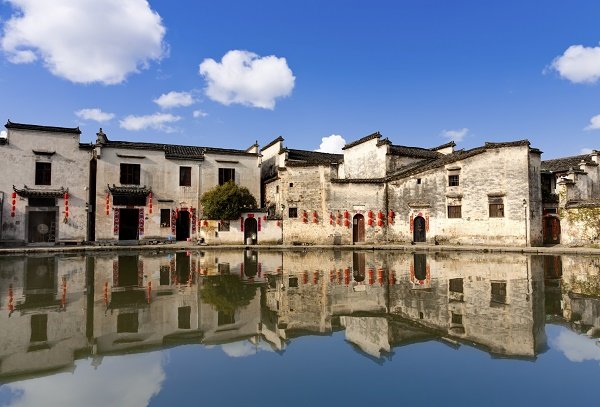
Beautifully preserved village of Hongcun near Huangshan
China has so much to offer the curious traveler that there’s simply no way to visit everywhere in just one trip. Most first time visitors cover the ‘must-see’ sites of Beijing, Xi’an, Shanghai and Guilin, but there’s so much more to discover and explore. Here we list our top places to visit on a second trip to China.
Huangshan
Our director Guy Rubin’s favorite destination in China is Huangshan – the Yellow Mountains. We recommend two days to enjoy the area fully – one day for exploring the mountain itself and one day for touring the picturesque villages that the area is also renowned for. Ascend the mountain top via a cable car, traversing the granite peaks and, depending on the weather, zipping in and out of swirls of mist. At the top one instantly appreciates the unique beauty of the mountain that has captivated artists and poets for centuries. Back down below, the beautiful villages around Huangshan offer a glimpse of a rural and somewhat idyllic China that is fast-disappearing. It’s hard not to fall for this area’s natural beauty and charming UNESCO heritage site villages.
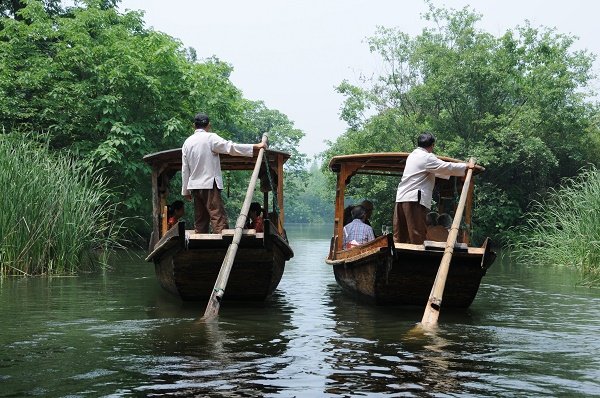
Taking a relaxing gondola ride on West Lake
Hangzhou
Only 2 hours from Shanghai and 3 hours from Huangshan is another China-highlight – the beautiful city of Hangzhou, which Marco Polo once proclaimed to be “by far the most glorious city in the world”. This city adjacent to the vast and serene West Lake is one in which to relax and explore Chinese culture and tradition. Enjoy a morning taichi lesson followed by a private gondola ride on West Lake to the accompaniment of your own private orchestra. The area surrounding Hangzhou is filled with Buddhist temples and peaceful tea plantations to explore during an afternoon. Hangzhou is also a great place to learn and appreciate the Chinese arts such as calligraphy or a tea ceremony.
Bronze masks at Sanxingdui
Chengdu
The city of Chengdu sometimes makes it on to people’s first time itinerary, and for good reason. Seeing and even holding pandas can be a highlight of your trip. There’s much more to Chengdu too – it’s a sophisticated and cosmopolitan city with great restaurants, shopping and nightlife and yet it still retains a very traditional character in its countless teahouses, temples and parks. Another nearby highlight is the archeological site of Sanxingdui, rivalling that of Xi’an’s Terracotta Warriors in historical importance. Take an afternoon to explore the spell-binding collection of bronze and gold masks and other jade and ivory artifacts dating from the 12th to 11th centuries BC.
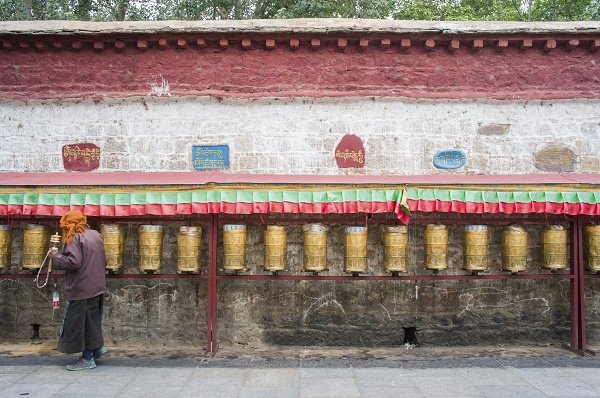
Spinning prayer wheels on the kora in Lhasa
Lhasa
If visiting Lhasa, Tibet we recommend a stay of 4 nights as there’s so much to see and this gives you time to acclimatize to the altitude. Most people therefore incorporate it into their second trip to China. The sights and atmosphere in Lhasa make it a truly special place to visit and another favorite of our director Guy Rubin. Visit the monasteries, temples and Potala Palace; witness the devotion of the pilgrims as you join them on the kora (pilgrimage); watch prayer flags fluttering in the wind against a backdrop of the mighty Himalayan peaks – it’s impossible not to be blown away by the splendor and raw beauty of Tibet.
To see a full itinerary incorporating Huangshan, Hangzhou, Chengdu and Lhasa click here. Other destinations we’d recommend exploring on a second visit to China are Lijiang, Shangri-La, Dunhuang and Pingyao / Datong. For advice on which destinations would suit you please contact us or one of our recommended travel agents.

View over Beijing's fabulous Forbidden City
Ever dreamed of standing on the Great Wall of China? Seeing the wondrous Terracotta Warriors with your own eyes? Gazing up at the brilliant neon skyline of Shanghai? At least once a year Imperial Tours runs The Majestic Tour, a luxury small group tour – maximum of 14 people – which intimately allows you to experience all the things you dreamed of and more. This is the highest-end group tour of China available and will take you on an unforgettable ten day journey around China…..in style. You will be amazed by at least one "wow" experience on each day of the trip!
This luxury tour starts in China’s fascinating capital, Beijing. Here you will visit the best of the imperial sites such as the Forbidden City, Summer Palace and Temple of Heaven. You will also visit the ancient alleyways, known as hutongs, still teeming with life today but where you will also catch a glimpse of the older, more traditional way of life. At bustling Panjiayuan antiques market you will join the locals as they buy and sell a huge range of Chinese cultural artifacts from all over China and Tibet. A two-hour drive out of Beijing and we will take you to a wonderful section of the Great Wall that will take your breath away!
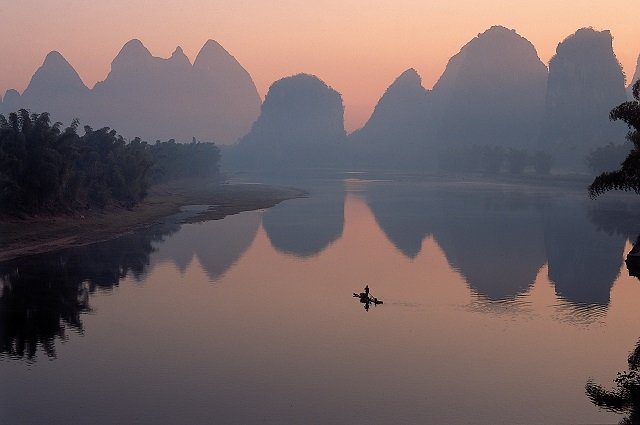
The dreamy Li river scenery near Guilin
The next stop on your luxury tour will be Xi’an – ancient capital of China and home to the Terracotta Warriors. The life-size Terracotta Army and Terracotta Horses are believed to have been buried around 210BC and their sight is truly marvelous to behold. Xi’an is also famed for its noodles so you will enjoy a private dumpling-making and noodle-throwing lesson by expert chefs – trust us, cooking has never been so much fun!
From Xi’an you will fly south to Guilin. This area of China is simply stunning. Layers of karst peaks dot the horizon and the Li and Yulong rivers wind their way through landscapes straight from a Chinese painting. Here you can experience rural China, where water buffalos plow the rice paddies and you can join villagers to learn how to make traditional soy milk and tofu. The luxury Banyan Tree hotel enjoys a tranquil riverside setting so you will have a morning to yourself for a swim in the pool or a stroll along the river. Just as relaxing will be your ride down the river on a bamboo raft – the scenery from this vantage point may well be a highlight of your China trip!
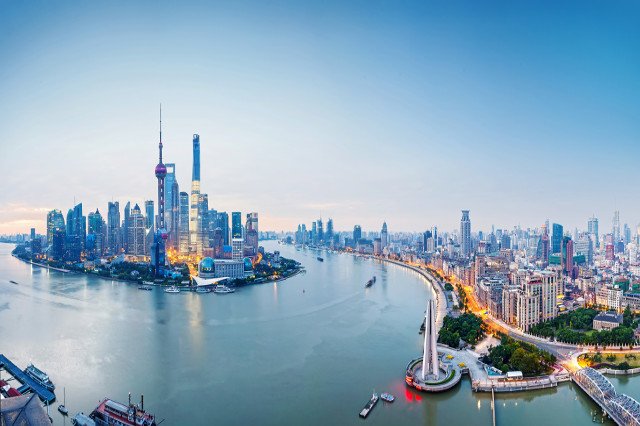
The 'wow' view of the Bund and Pudong in Shanghai
Final stop: Shanghai. This city is simply buzzing and nowhere more so than on the riverside Bund, overlooking the bright lights and mega skyscrapers of Pudong. To really understand this city, you’ll be given a guided walking tour of this area’s colonial architecture, followed by a trip into the elegant tree-lined streets of the French Concession. You will also have the chance to do what Shanghai does best – dining and shopping! For a classic evening of entertainment you will be taken to an acrobatics show – prepare to be wowed as these acrobats make the impossible possible! On the final day of your luxury China tour we will visit the Shanghai Museum and take a stroll around the classical Chinese Yu Gardens, a beautiful haven right in the center of bustling downtown Shanghai. In the evening you will be treated to a fabulous farewell meal at one of our favorite restaurants – a fitting end to your unforgettable trip around China…..in style!
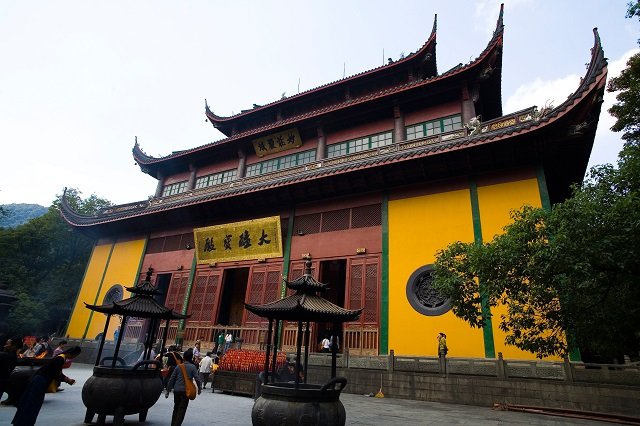
Lingyin Temple (Temple of the Soul's Retreat), Hangzhou
However, if ten days of luxury touring in China is not enough then you can add our two-day tour extension to Hangzhou. Hangzhou’s enchanting lake-side setting will certainly delight. Here you will take a ride on a gondola across West Lake, visit nearby tea plantations and temples, learn about traditional Chinese medicine and take a Taichi class with an expert. This tour extension will give you a deeper insight into traditional Chinese culture and will be a truly relaxing way to end your China holiday…..in style. See the Hangzhou itinerary here.
To read the full Majestic Tour luxury travel itinerary, including details of the 5* luxury hotels included, click here. Book before October 31, 2015 to receive this special rate!
Offers: We are offering a Friends and Family booking special whereby if 4 or more guests book together, each will receive:
$150pp credit towards a tour enhancement (this can be used towards flight or suite upgrades or Diplomatic Channel access); or dinner at a restaurant of your choice (value of up to $125 per person) on one of the evenings at leisure in Beijing or Shanghai.
For more details or for booking enquiries please email us.

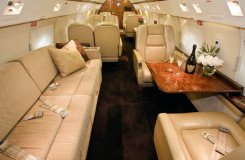
Take your trip to China to unparalleled heights, courtesy of the new partnership between Imperial Tours and Presidential Private Jet Vacations. Now flexibility and luxury intersect at a point of perfection that will make each and every moment of your visit to the Middle Kingdom…Imperial.
Over the course of seventeen days you will experience and personally connect with the extensive culture, history and beauty that define both ancient and contemporary China, all while effortlessly dashing between cities on your own private jet.
From entering a closed-off section of the Forbidden City to walking a lesser-known area of the Great Wall, meeting the Terracotta Warriors up close, relaxing on a bamboo raft as you drift by magical karst mountain scenery, and marveling at the rapid development of Shanghai, China will open your eyes and heart to a land lingering in tradition while simultaneously leading the world in so many sectors. Private jet travel only makes these wonders more accessible and exclusive.
Included in the trip are: accommodation in the best luxury hotels in China, private jet transportation and onboard gourmet catering, best available ground transportation, unparalleled sightseeing and access, a Western China Host accompanying you the entire way catering to your every need, meals in the country’s finest restaurants, and of course personalization of any and all aspects of your trip. This is the ultimate luxury experience in China.
For a detailed itinerary and to inquire about customizing a trip, please visit China Private Jet Vacation or contact us.